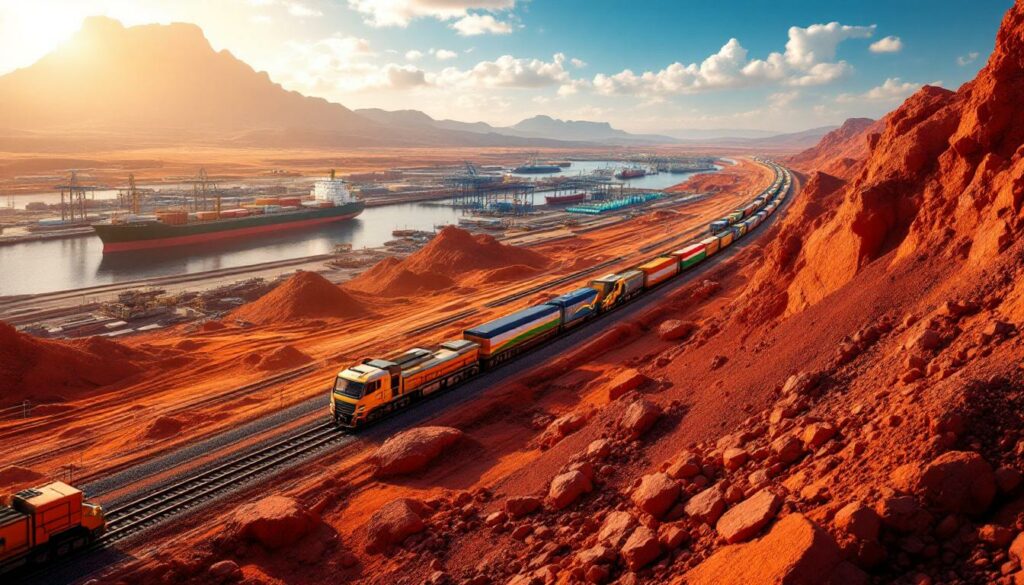Kumba Iron Ore's 3% Sales Growth: Logistics Improvements and Market Impact
South Africa's largest iron ore producer, Kumba Iron Ore, has reported a 3% increase in sales volumes for the first half of 2025, reaching 18.7 million metric tons compared to 18.1 million tons in the same period last year. This growth comes despite the persistent challenges in South Africa's mining logistics sector, highlighting the effectiveness of recent collaborative efforts to improve rail and port operations.
The company's improved performance reflects significant advancements in South Africa's mineral export infrastructure, with potential long-term implications for the entire mining industry evolution and the country's economy.
How Has Kumba Iron Ore Improved Its Performance in 2025?
Kumba's first-half 2025 results demonstrate meaningful progress in overcoming South Africa's notorious logistics bottlenecks. The company has maintained its full-year production and sales guidance at 35-37 million metric tons, signaling confidence in continued operational improvements throughout the year.
Kumba's First-Half 2025 Performance Highlights
Kumba's trading update revealed several key improvements:
- Sales volume increased 3% to 18.7 million metric tons (compared to 18.1 million tons in H1 2024)
- Headline earnings projected between 6.841-7.341 billion rand ($389.40-$417.86 million)
- Rail transport volumes increased 4% to Saldanha Bay port
- Production and sales forecast maintained at 35-37 million metric tons for full-year 2025
- Significant improvement in equipment availability at port facilities
The company stated in its trading update that "the collaborative partnership between the ore users' forum and Transnet on the ore corridor restoration programme is starting to deliver positive outcomes in terms of logistics performance." This collaboration represents a new approach to solving the country's persistent infrastructure challenges.
Key Factors Behind the Sales Growth
The 3% sales growth was not achieved by chance but through strategic initiatives:
- Enhanced collaboration with Transnet through the ore corridor restoration program
- Technical assistance provided to the state-owned logistics operator
- Equipment support to improve operational reliability
- Strategic partnerships yielding measurable logistics improvements
- Inflation offset through higher sales volumes and operational efficiencies
The company's ability to increase rail volumes by 4% during a period when many other exporters continue to struggle with logistics constraints demonstrates the effectiveness of its collaborative approach with Transnet.
What Challenges Has South Africa's Iron Ore Industry Faced?
Despite recent improvements, South Africa's iron ore industry continues to battle significant infrastructure constraints that have limited its growth potential for years.
Persistent Logistics Bottlenecks
The mining sector has long struggled with:
- Chronic underperformance of state-owned Transnet freight rail services
- Equipment shortages affecting consistent transport capacity
- Widespread cable theft and infrastructure vandalism
- Forced production cuts to match limited logistics capacity
- Negative impact on export potential and market competitiveness
Transnet has for years struggled to provide adequate services, citing equipment shortages, cable theft, and vandalism as major challenges. These issues have forced mining companies, including Kumba, to limit production to align with available transport capacity, significantly constraining export volumes and revenue.
Proposed Solutions and Interventions
The industry has proposed several solutions to address these persistent challenges:
- Private sector investment proposals for key infrastructure
- Kumba's suggestion for private investors to operate the 861-kilometer rail line
- Industry-wide technical assistance to improve operational efficiency
- Collaborative approach between mining companies and state logistics provider
- Equipment sharing arrangements to maximize available resources
Kumba has been at the forefront of proposing solutions, including advocating for private operation of the critical 861-kilometer rail line that connects its mines to Saldanha Bay port. The company believes this approach could significantly improve reliability and throughput.
"The ore corridor restoration programme demonstrates how public-private collaboration can deliver tangible improvements in logistics performance, even under challenging circumstances," noted mining industry analysts familiar with South Africa's export infrastructure challenges.
How Important Is Kumba in the Global Iron Ore Market?
Kumba Iron Ore plays a significant role in both the African mining landscape and the global iron ore market, with its performance serving as an indicator of broader iron ore price trends and industry dynamics.
Kumba's Market Position
Kumba holds several distinguished positions in the market:
- Africa's largest iron ore producer with significant export capacity
- Operator of flagship Sishen mine, one of the world's largest open pit operations
- Anglo American subsidiary with access to global marketing networks
- Strategic supplier to global steel markets, particularly in Asia and Europe
- Producer of high-quality ore with 64-65% iron content, commanding premium pricing
The company's Sishen mine in Northern Cape province ranks among the world's most significant iron ore operations, producing ore that is particularly valued for its quality characteristics and consistency.
Economic Impact and Significance
Kumba's operations have substantial economic implications:
- Major employer in South Africa's mining sector with over 11,000 direct employees
- Substantial contributor to national export earnings, accounting for approximately 2% of total exports
- Strategic importance to regional development in Northern Cape province
- Indicator of broader South African mining industry health
- Bellwether for infrastructure and logistics challenges facing resource exporters
The company's performance directly impacts thousands of jobs and contributes significantly to South Africa's foreign exchange earnings, making its operational success a matter of national economic importance.
What Are the Broader Implications for South Africa's Mining Sector?
The improvements in Kumba's logistics arrangements could signal a potential turning point for South Africa's broader mining sector, which has long been constrained by infrastructure limitations.
Infrastructure Reform Opportunities
Recent developments suggest several reform possibilities:
- New government openness to rail reform initiatives
- Growing consensus on need for private sector participation
- Precedent-setting nature of logistics collaborations like the ore corridor restoration program
- Possible structural changes to state-owned enterprise model
- Impact on other mineral exporters facing similar constraints
South Africa's new government has shown increased receptiveness to private sector participation in critical infrastructure, potentially creating opportunities for similar arrangements across other export corridors.
Investment Outlook and Future Prospects
These developments may reshape investment perspectives:
- Stronger relationship between logistics improvements and production expansion
- Potential for increased foreign direct investment with infrastructure reforms
- Competitive repositioning against global iron ore producers like Australia and Brazil
- Sustainability of collaborative logistics improvement initiatives
- Long-term viability enhancement of South African mineral export sector
Investors are closely monitoring these developments, as sustainable logistics improvements could unlock significant value in South Africa's mining assets that has been constrained by infrastructure limitations.
How Does Rail Performance Impact Mining Economics?
The economics of mining in South Africa are inextricably linked to logistics performance, with rail capacity often being the determining factor in production decisions.
The Economics of Mining Logistics
Rail performance affects mining operations in multiple ways:
- Direct correlation between rail capacity and production volumes
- Impact of logistics constraints on unit costs and profitability
- Opportunity cost of unrealized export potential during high price periods
- Capital allocation decisions influenced by transport reliability
- Competitive disadvantage against more efficient export markets like Australia
For Kumba and other South African miners, the cost of unreliable rail service extends beyond direct logistics expenses, impacting investment decisions, production planning, and international competitiveness.
Measuring Logistics Efficiency Improvements
Several key metrics help quantify logistics improvements:
- Rail cycle times between mines and ports
- Equipment availability rates for locomotives and wagons
- Port loading efficiency measured in tons per hour
- Demurrage costs for vessels waiting to be loaded
- Return on investment for logistics infrastructure improvements
Kumba's recent 4% improvement in rail volumes represents a significant efficiency gain that has directly translated to improved sales performance, demonstrating the leveraged effect of logistics enhancements on overall business results.
What Are the Prospects for Private Sector Rail Investment?
The possibility of increased private sector participation in South Africa's rail infrastructure represents a potential paradigm shift in how the country manages its strategic export corridors.
Models for Private Participation in Rail Infrastructure
Several models are being considered:
- Concession structures for the 861-kilometer ore corridor
- Build-operate-transfer arrangements for specific sections of infrastructure
- Private investment in rolling stock with access rights to the network
- Joint ventures between Transnet and mining companies
- Full privatization of certain rail lines
These models draw on international precedents while addressing South Africa's specific circumstances, including historical concerns about private control of strategic infrastructure.
Stakeholder Perspectives on Rail Reform
Various stakeholders have different views on rail reform:
- Government officials weighing strategic versus operational considerations
- Labor unions concerned about employment implications
- Mining companies seeking reliability improvements
- Investors evaluating long-term infrastructure opportunities
- Communities dependent on mining employment
The complexity of these perspectives necessitates careful balancing of interests to achieve reforms that deliver both operational improvements and broader social benefits.
Future Outlook for South African Iron Ore Exports
Looking ahead, South Africa's iron ore export sector faces both challenges and opportunities as it works to overcome historical constraints.
Short-Term Projections (2025-2026)
In the immediate future, we can expect:
- Continued collaboration between miners and Transnet on operational improvements
- Incremental increases in rail and port performance metrics
- Potential for modest production increases within existing constraints
- Implementation of targeted efficiency initiatives focused on bottlenecks
- Evaluation of private sector participation models for rail infrastructure
The ore corridor restoration program will likely continue to yield gradual improvements, potentially allowing Kumba to exceed its current production guidance if progress accelerates.
Long-Term Strategic Considerations (2026-2030)
Looking further ahead, more fundamental changes may emerge:
- Structural reforms to logistics infrastructure management
- Potential for significant capacity expansion with private investment
- Competitive repositioning in global iron ore markets
- Integration with broader African infrastructure development initiatives
- Sustainability initiatives to reduce carbon footprint of mineral transport
These longer-term developments will determine whether South Africa can fully capitalize on its mineral resources and compete effectively with other major iron ore producers like Australia and Brazil. The iron ore forecast 2025 suggests continued demand strength, making these infrastructure improvements even more critical for South African producers.
According to a recent report by Mining.com, the progress made through public-private collaboration on logistics has shown promising results that could be replicated across other mineral supply chains.
Disclaimer: The projections and forward-looking statements in this article are based on current information and subject to significant uncertainties. Actual outcomes may differ materially from those suggested. Readers should conduct their own due diligence before making investment or business decisions.
FAQ: Kumba Iron Ore and South African Mining Logistics
What caused Kumba's improved sales performance in 2025?
Kumba's 3% sales growth resulted from better rail freight and port operations following collaborative efforts with Transnet. Rail transport volumes increased 4% to Saldanha Bay, and equipment availability at the port improved significantly during the first half of 2025.
How has Transnet's performance affected South African mining companies?
Transnet's ongoing challenges with equipment shortages, cable theft, and vandalism have forced mining companies like Kumba to reduce production to match limited logistics capacity, directly impacting export potential and profitability across the sector.
What solutions has Kumba proposed for logistics challenges?
Kumba has suggested private investors should operate the 861-kilometer rail line from its mines to Saldanha Bay port to enhance efficiency. The company has also provided technical and equipment assistance to Transnet as part of a collaborative industry approach.
How significant is Kumba in the global iron ore market?
As Africa's largest iron ore producer, Kumba plays an important role in global supply chains. Its flagship Sishen mine ranks among the world's largest open pit operations, making the company a significant contributor to international iron ore demand insights.
What are the potential benefits of rail infrastructure reform in South Africa?
Rail reform could unlock production capacity, improve export competitiveness, attract foreign investment, reduce unit costs, and create a more sustainable mining sector with greater employment and economic benefits for South Africa. Recent resumed iron haulage operations in other regions demonstrate how improved logistics can boost the entire mining value chain.
According to the Polity.org report, the success of Kumba's logistics collaboration could serve as a model for other South African export industries facing similar infrastructure constraints.
Want to Capitalise on the Next Major Mineral Discovery?
Discovery Alert's proprietary Discovery IQ model delivers real-time notifications on significant ASX mineral discoveries, instantly transforming complex data into actionable insights for both short-term traders and long-term investors. Explore how historic discoveries have generated substantial returns by visiting Discovery Alert's dedicated discoveries page.




